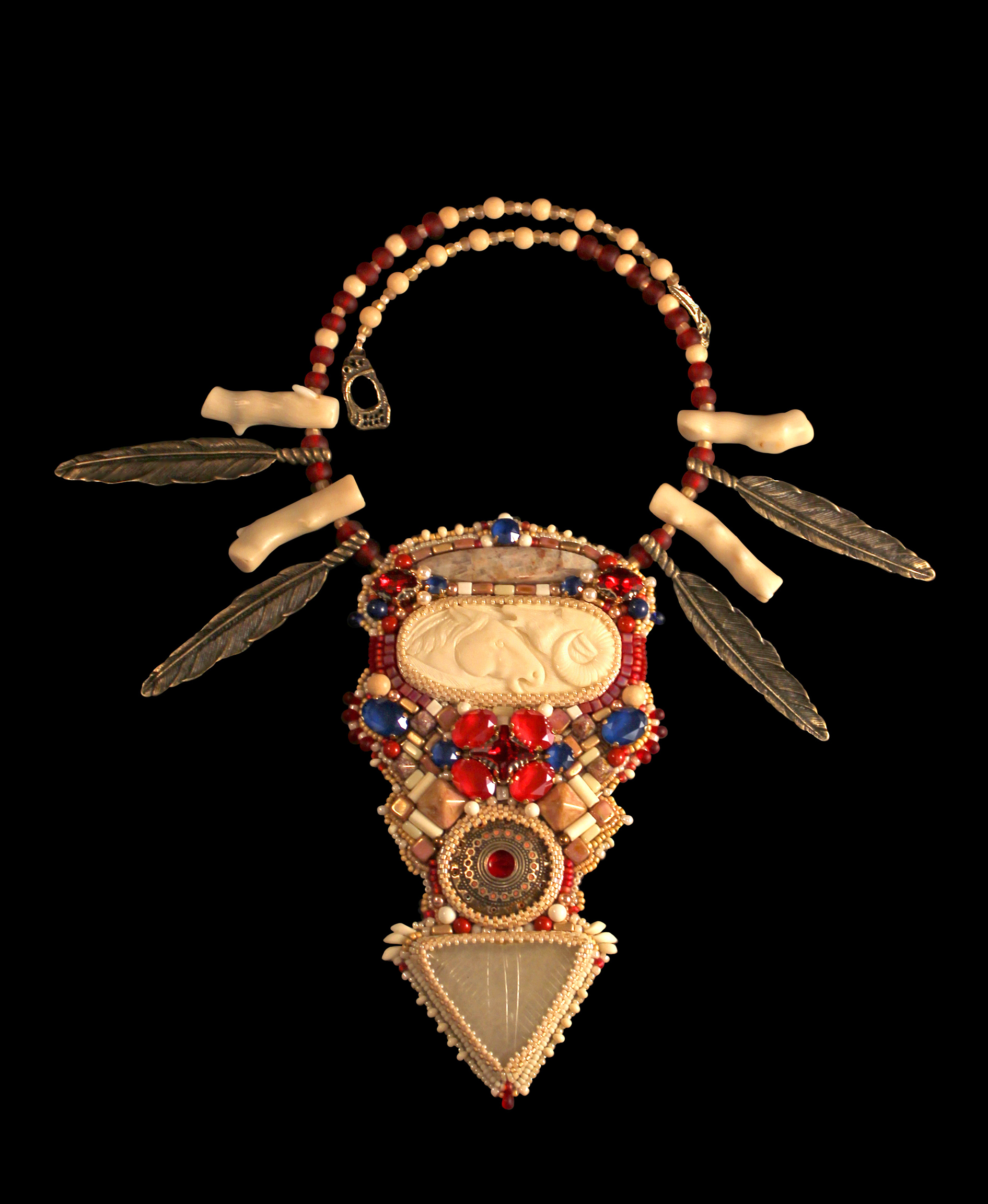Источником вдохновения для создания колье «Дух Великой Степи» послужили культура и искусство скифо-сакских кочевых племен, населявших территорию Средней Азии в первом тысячелетии до нашей эры. Великая Степь раскинулась от берегов Черного и Азовского моря до горных отрогов Тянь-Шаня. Все культура саков-кочевников строилась на животноводстве, и образы коня и барана – ключевые в искусстве того периода. Неслучайно скифо-сакский стиль в искусстве называют еще звериным.
Цветовая триада белый – красный – синий очень характерна для культуры кочевников Евразии. В сочетании с оттенками бронзы и золота, эти три цвета были наиболее распространенными в культуре саков. Белый – очень позитивный оттенок, это цвет молока, овечьей шерсти, плодородия. Красный цвет являлся выразителем активной жизненной силы, стихии огня, молодости. Синий цвет олицетворял небесную высь, верхний мир – мир бога неба Тенгри, обиталище добрых духов. Бронза и золото были наиболее распространенными металлами в сакском искусстве.
Я использована символику цвета и тотемных образов (конь, баран, сокол), чтобы создать украшение, отражающее богатую мифопоэтику сакской культуры. Геометрическая форма элементов, использованных в колье, также имеет значение. Круг – солярный знак, треугольник – защитный знак. Соединенные вместе, эти элементы наделяют колье функциями тотема и оберега, а также закладывают пожелания благополучия и плодородия.
Материалы, использованные в работе:
Swarovski Oval Tribe fancy stone, Swarovski Rhombus Tribe fancy stone. Swarovski Ovals 14mm, Xirius Chatons SS39, SS29 (цвета Lacquer Royal Red и Royal Blue), жемчуг Swarovski (цвета Ivory, Red Coral, Dark Lapis Blue), кабошон из резной кости, резной оникс, кабошон беломорита, японский бисер Miyuki и Toho, чешский бисер, палочки коралла, деревянные бусины, фурнитура Анны Черных, фурнитура под бронзу, проволока с эффектом памяти, натуральная кожа.
The inspiration sources for my necklace «Spirit of the Great Steppe» are the culture and art of the Scythian-Saka nomad tribes, who inhabited the territory of Central Asia in the first millennium BC. Great Steppe extends from the shores of the Black and Azov Sea to the mountain spurs of the Tian Shan. The culture of Saka nomads was based on livestock, and the images of horses and sheeps are key to the art of that period. Therefore the Scythian-Saka art style is also called an animal style.
The color triad White — Red — Blue is very typical for the culture of the nomads of Eurasia. In combination with the bronze and gold, these three colors are most common in the culture of Saka. White has very positive meaning, it is the color of milk, sheep’s wool, fertility. Red express an active life-force, youth, the element of fire. Blue symbolizes the heavenly heights, the upper world — the world of Tengri, the God of Sky, the abode of good spirits. Bronze and gold are the most common metals in Saka art.
I used the symbolism of colors and totemic images of Saka culture (horse, sheep and falcon) to create a necklace that reflects the rich mythopoetics of Saka culture. The geometric shape of the elements that I used in the necklace is also important. Circle is a solar sign, triangle is a protective sign. All together in one necklace, these elements have the meaning of totem and talisman, as well as the wishes of prosperity and fertility.
Materials:
Swarovski Oval Tribe fancy stone, Swarovski Rhombus Tribe fancy stone. Swarovski Ovals 14mm, Xirius Chatons SS39, SS29 (Lacquer Royal Red, Royal Blue), Swarovski pearls (Ivory, Red Coral, Dark Lapis Blue), carved bone cabochon, carved onyx, belomorite cabochon, japanese seed beads (Miyuki and Toho), Czech seed beads, coral sticks, wooden beads, bronze supplies, memory wire, natural leather.

